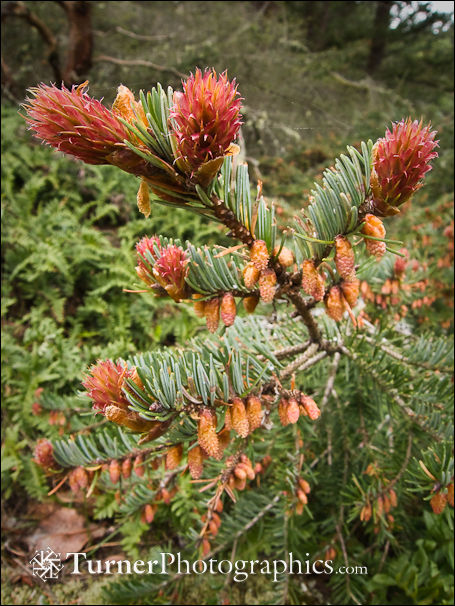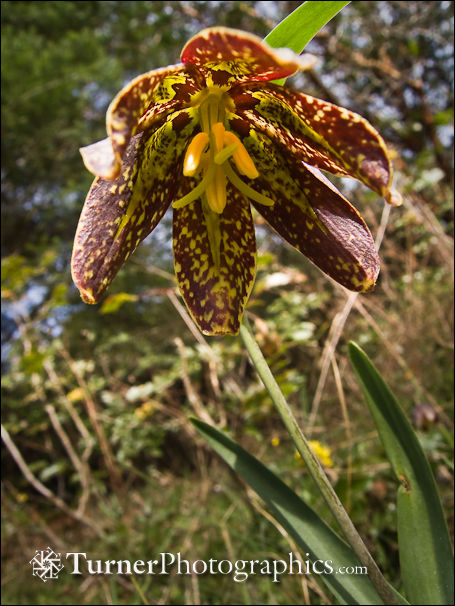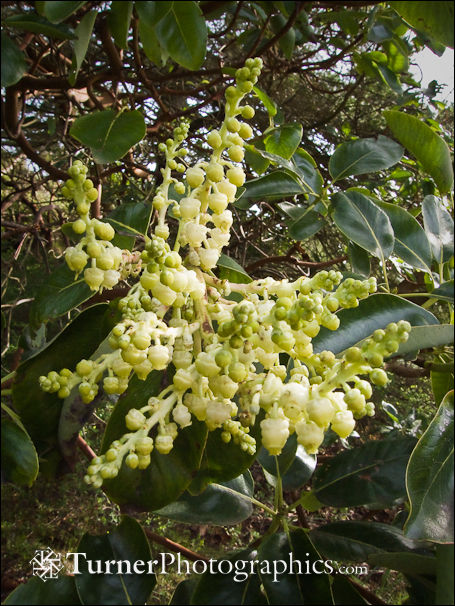Sex and the Single Pseudotsuga
 Sex was in the air all over Pass Island and West Beach at Deception Pass State Park this weekend. Bright red female Douglas-fir cones standing tall on branch tips were calling out to the pollen-laden male cones hanging below. “Hit me with some of your dusty golden pollen,” they seemed to be saying. And with every stiff branch-shaking breeze (or human hand) the air would blaze with the pixie dust so essential to the Pseudotsuga menziesii mating ritual.
Sex was in the air all over Pass Island and West Beach at Deception Pass State Park this weekend. Bright red female Douglas-fir cones standing tall on branch tips were calling out to the pollen-laden male cones hanging below. “Hit me with some of your dusty golden pollen,” they seemed to be saying. And with every stiff branch-shaking breeze (or human hand) the air would blaze with the pixie dust so essential to the Pseudotsuga menziesii mating ritual.
Courtship among trees is obviously a bit different than it is among more mobile species, but the basic process is the same. Sperm and egg come together, fertilization occurs, and a new member of the species begins to grow. The female, carrying the eggs, somehow has to attract the male. Plants have evolved myriad ways for this to happen, often involving third parties like insects or other animals.
Conifers are wind-pollinated. Look closely at the Douglas-fir bough. There are just a couple of red female flowers near the branch tips while there are many more males hanging down below. Since cross-pollination, mixing genes between individuals, is valuable in a long-term evolutionary sense the species has developed a mechanism to keep self-fertilized embryos from completely developing into viable seeds. I don’t understand just how that works. Try a web search on “Pseudotsuga self fertile” if you want to figure it out.
The female cones are standing upright, presumably to make it easier for the wind-borne pollen to be ensnared as it drifts by. Once the flowers are fertilized then the cones will turn downward, which is the way we usually see Doug-fir cones on the tree.
This weekend was the first time I’d noticed Douglas-fir in bloom after nearly 20 years of seeing this most common of northwest conifers. Why hadn’t I noticed it before? Probably just not in the right place at the right time. I know I’ll be looking for them in the future.
 A favorite early-blooming member of the Lily family is the Checker Lily, also known as Chocolate Lily or Mission Bells. We found several patches of them beginning to bloom on Pass Island, and many more young plants that won’t bloom this year. Mature, bloom-size plants have whorls of leaves surrounding the stem below the pendant blossom. Young plants have a single long lance-shaped leaf that lies close to the ground. If you didn’t see a mature plant in the group you might not recognize the foliage of the babies. I’ve noticed the same thing with other members of the family.
A favorite early-blooming member of the Lily family is the Checker Lily, also known as Chocolate Lily or Mission Bells. We found several patches of them beginning to bloom on Pass Island, and many more young plants that won’t bloom this year. Mature, bloom-size plants have whorls of leaves surrounding the stem below the pendant blossom. Young plants have a single long lance-shaped leaf that lies close to the ground. If you didn’t see a mature plant in the group you might not recognize the foliage of the babies. I’ve noticed the same thing with other members of the family.
Checker Lily, Fritillaria affinis, flowers always hang down from the end of the stem. You either have to lift the blossom with your fingers or get down on the ground and look up to see the beautiful pattern on the petals inside the flower. The down-facing habit is most likely an adaptation to keep its sex parts dry and ready for pollinating insect visitors.
 Up here in our corner of the northwest, Madrona, Arbutus menziesii, trees only grow on well-drained and usually rocky soils along the coast. Farther south you’ll also find them farther inland. They’re a beautiful broadleaf evergreen with distinctive peeling bark. They’re members of the Heath family, same as Rhododendrons, Huckleberries, and Heathers.
Up here in our corner of the northwest, Madrona, Arbutus menziesii, trees only grow on well-drained and usually rocky soils along the coast. Farther south you’ll also find them farther inland. They’re a beautiful broadleaf evergreen with distinctive peeling bark. They’re members of the Heath family, same as Rhododendrons, Huckleberries, and Heathers.
The Madronas were just starting to bloom on Saturday. Big showy clusters of bell-shaped creamy white flowers are held near the branch tips. Each individual flower is complete, with both male and female parts. The technical term for that is “perfect.” Later, bright orange berries will take their place.
These photos were made on a Washington Native Plant Society field trip that I led. We had about a dozen people along and spent the day slowly exploring Pass Island and West Beach. Everyone found something new they hadn’t seen before. One of the surprises was finding Grand Fir and Western Yew growing in sand at the back edge of the dunes along West Beach. Both generally prefer richer soil.
Here’s more from the day:
I carried my handy pocket camera, a Canon S70, which let me photograph quickly and spend most of my time talking with trip participants about the plants. The video was created with Animoto. You can explore the photos, with captions, in a more leisurely fashion at Deception Pass on Pacific Northwest Wildflowers.


Mark,
Thank you for these! I’ve never seen the active PSME cones. And I always love seeing Fritillaria in the spring, even on the screen.
Cindy
Looks like you are at about the same flowering paceas we are down here. Also saw our first Frit. last Thursday. Of course out at O’Brien and it was the 6 in. form. They are often single flowered or just a couple on the short stem and some have yellow base coloring. The ones in the garden grown from seed will bloom this week. Also saw Trillium rivale by the hundreds. The best (huge) were near Patrick’s Creek about 2 miles up the creek from 199.
We also found Garrya fremontii a little further up the hill. It was hanging right over the road, yelling at us to stop and take a look. It had been a very long time since I had seen one. Thanks for reminding us to watch for it!
Loved seeing the cones!
First time I’ve felt naughty reading your blog, Mark. Strong work.
When in Deception Pass, you should look for Trifolium depauperatum. It is cited in Hitchcock as introduced, but I belive that it is native there, as well as here, on Vancouver Island.
Also, Limnanthes macounii should be hiding somewhere there along the wet spots (depressions of seeps) along the shore.
Cheers,
Adolf
If you want to see conifer pollen in action take a look at what my Baker Cypress did in my yard at the end of January.
or search youtube with Baker cypress pollination.
That’s some heavy pollen, Frank. The Doug-firs let loose a lot, but not that big a cloud.
I passed your photos on to some non-NPS members–they were amazed, as I was, by the rich exotic quality of the fir sexual parts. They are beautiful–you captured them in a way I never saw before.
Thank you for sharing!
Martha Dyck
Pingback: Blooming Spruce « Lisa deGruyter
Several years back, I remember being out at Horse Rock Ridge here in Oregon very early and being shocked by how bright the raspberry-colored new cones were. I live in a Doug-fir forest, and I rarely see them. I wonder if the color varies from tree to tree or year to year, or if as you say, most of the excitement happens so high above us we don’t notice. Thanks for reminding me about this.